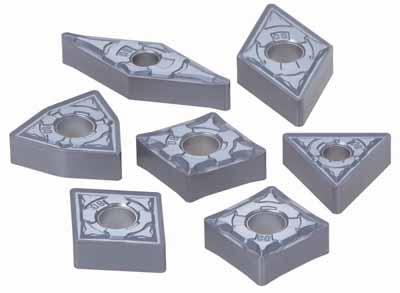
Tungaloy Corp. has introduced the AH8000 series of PVD grades and chipbreakers for turning heat resistant alloys.
The new PVD grades feature impressive resistance to both wear and fracture due to the world’s first nano-multi-layered AlTiN coating with high Al content and dramatically reduces notch wear, crater wear and built-up edge in machining heat resistant alloys. The two AH8000 grades include AH8015, the first choice grade with well-balanced wear and fracture resistance; AH8005, the high hardness grade with excellent wear resistance. These two new grades are treated with PremiumTec, Tungaloy’s special surface technology, which adds a highly polished cutting surface for extra stability and long tool life.
The new chipbreakers, HRF and HRM, cover a wide range of applications from finishing to medium cutting. The HRF chipbreaker for finishing provides low cutting force due to the large rake angle and inclination on the cutting edge, delivering excellent chip control particularly when machining in low depth-of-cut ranges. The HRM chipbreaker for finishing to medium cutting features a protrusion on the rake surface. This protrusion minimizes the swarf from contacting the rake surface and dramatically decreases built-up edge.
These new grades and chipbreakers in the AH8000 series offer outstanding cutting performance in various turning operations from finishing to medium cutting of heat resistant alloys, resulting in a remarkable increase in customer productivity.
Contact Details
Related Glossary Terms
- alloys
alloys
Substances having metallic properties and being composed of two or more chemical elements of which at least one is a metal.
- built-up edge ( BUE)
built-up edge ( BUE)
1. Permanently damaging a metal by heating to cause either incipient melting or intergranular oxidation. 2. In grinding, getting the workpiece hot enough to cause discoloration or to change the microstructure by tempering or hardening.
- chipbreaker
chipbreaker
Groove or other tool geometry that breaks chips into small fragments as they come off the workpiece. Designed to prevent chips from becoming so long that they are difficult to control, catch in turning parts and cause safety problems.
- cutting force
cutting force
Engagement of a tool’s cutting edge with a workpiece generates a cutting force. Such a cutting force combines tangential, feed and radial forces, which can be measured by a dynamometer. Of the three cutting force components, tangential force is the greatest. Tangential force generates torque and accounts for more than 95 percent of the machining power. See dynamometer.
- hardness
hardness
Hardness is a measure of the resistance of a material to surface indentation or abrasion. There is no absolute scale for hardness. In order to express hardness quantitatively, each type of test has its own scale, which defines hardness. Indentation hardness obtained through static methods is measured by Brinell, Rockwell, Vickers and Knoop tests. Hardness without indentation is measured by a dynamic method, known as the Scleroscope test.
- physical vapor deposition ( PVD)
physical vapor deposition ( PVD)
Tool-coating process performed at low temperature (500° C), compared to chemical vapor deposition (1,000° C). Employs electric field to generate necessary heat for depositing coating on a tool’s surface. See CVD, chemical vapor deposition.
- rake
rake
Angle of inclination between the face of the cutting tool and the workpiece. If the face of the tool lies in a plane through the axis of the workpiece, the tool is said to have a neutral, or zero, rake. If the inclination of the tool face makes the cutting edge more acute than when the rake angle is zero, the rake is positive. If the inclination of the tool face makes the cutting edge less acute or more blunt than when the rake angle is zero, the rake is negative.
- swarf
swarf
Metal fines and grinding wheel particles generated during grinding.
- turning
turning
Workpiece is held in a chuck, mounted on a face plate or secured between centers and rotated while a cutting tool, normally a single-point tool, is fed into it along its periphery or across its end or face. Takes the form of straight turning (cutting along the periphery of the workpiece); taper turning (creating a taper); step turning (turning different-size diameters on the same work); chamfering (beveling an edge or shoulder); facing (cutting on an end); turning threads (usually external but can be internal); roughing (high-volume metal removal); and finishing (final light cuts). Performed on lathes, turning centers, chucking machines, automatic screw machines and similar machines.
- wear resistance
wear resistance
Ability of the tool to withstand stresses that cause it to wear during cutting; an attribute linked to alloy composition, base material, thermal conditions, type of tooling and operation and other variables.

